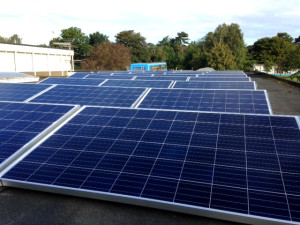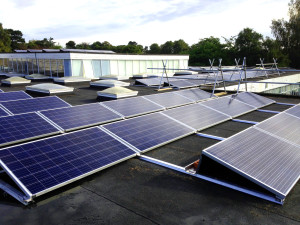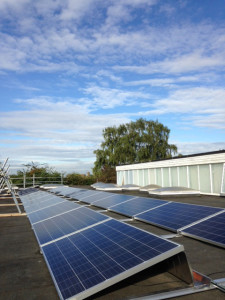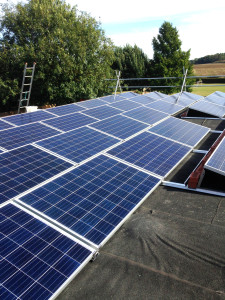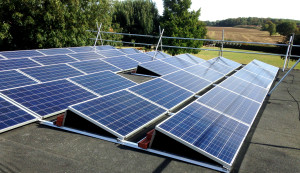What do the panels look like?
The panels at Morgans Primary School:
The panels at Hunsdon JMI school:
What is the Feed-In Tariff?
The UK government introduced the Feed-In Tariff on 1 April 2010 as a replacement for government grants as the main financial incentive to encourage uptake of renewable electricity-generating technologies. The idea is to offer domestic or small scale generators a guaranteed income for the renewable energy they generate. At present (2013) the FIT rate is guaranteed for 20 years from the date of qualification and pays back about 17p per unit of electricity (measured in kwhs). The UK Government’s Department for Energy and Climate Change (DECC) makes the key decisions on FITs in terms of government policy. The energy regulator Ofgem administers the scheme. You can find out more from The Energy Saving Trust
What are community shares?
There is no simple legal definition of community shares – we use the term to refer to a form of share capital called ‘withdrawable shares’ which can only be issued by co-operatives or community benefit societies. Withdrawable share capital cannot be transferred between people. Instead, the society allows shareholders to withdraw their share capital, subject to terms and conditions that protect the society’s financial security. The value of shares is fixed and not subject to speculation, although some societies have the power to reduce share values if the society is experiencing financial difficulties. Shareholders have only one vote, regardless of the size of their shareholding, so the society is democratic. There is a limit on personal shareholdings, currently up to £20,000.
For more, see this guide to community shares from the Co-op
Are these shares regulated by the Financial Conduct Authority (FCA)?
Industrial and Provident Societies are registered by the FCA, but societies are not required to be authorised by it for the issue of withdrawable shares. This means that community investors have no right of complaint to the Financial Ombudsman Service and cannot apply to the Financial Services Compensation Scheme.
What are the risks for share holders?
No investment is risk-free and Hertford Energy Now cannot guarantee that money invested in the Mill Mead Solar Array is completely safe. For example, we cannot control the weather, and though meteorologists can predict with high certainty how much sunlight Hertford usually receives during the year, it is possible that we could experience an unusually bad season and generate less electricity than predicted. However it is important to remember that over the 20 year project period, any bad year is likely to be balanced by years in which the panels receive extra sun. In fact, there is growing evidence from other schemes that solar panels tend to perform better than expectations.
There is also the risk that the school could be damaged or destroyed, or that Mill Mead’s roof will need to be replaced. The panels will be insured, and we would expect that any interruption to generation (should the roof require repairs, say) would only last a short period.
There is very little to go wrong with solar panels but it is possible that part of the system could fail. The panels themselves come with a 30 year warranty and are self-cleaning. The only other components that could fail are the electrical “inverters” which convert the DC electricity from the panels to AC for the mains. However these components have a 5 year warranty, and our financial models include a contingency fund to pay for replacement should this be required.
Finally there is a small risk that the government could decide to terminate the FIT scheme, but given the ongoing need to reduce emissions and decarbonise our electricity generation system, this is unlikely to occur. We have carried out a detailed risk assessment which is available on request.
What other community energy schemes exist?
There are around 1000 community energy schemes already running across the UK, with more than 800 in Scotland. Most projects (in Scotland, at least) are focused on wind generators, but some are based around hydro-electric generation on rivers – Settle Hydro, and Torr Mills Hydro, for example – and there is a growing number which use solar PV generators (Green Energy Nayland, Bath and West Community Energy, Brixton Energy to name a few). New ones are being launched all the time – you can find details on the Co-op’s community shares directory here and on the Microgenius site here. In other words, we are certainly not alone in thinking this is a good idea.
What is in it for the directors?
The directors stand to gain exactly the same benefits as any other investors in the scheme, plus the excitement and satisfaction of helping to establish an innovative project that will benefit the community for decades to come.
What emissions do solar panels release from their manufacture?
Like any other technology, solar panels require energy during manufacture and this will release greenhouse gases. But a recent cradle-to-grave analysis by a team at the US Government (a meta-analysis of more than 2,000 studies across many generation technologies) found that coal-fired energy releases about 20 times as much greenhouse gas into the atmosphere per kilowatt-hour as solar energy. It is expected that gas-fired energy releases about 10 times more than solar energy.
In detail, they found that, on average, solar panels release just 45 grams of carbon per kilowatt-hour of electricity produced, versus more than 1 kilogram for coal-fired energy.
More to come…

